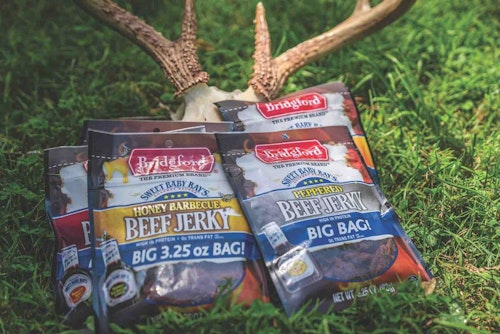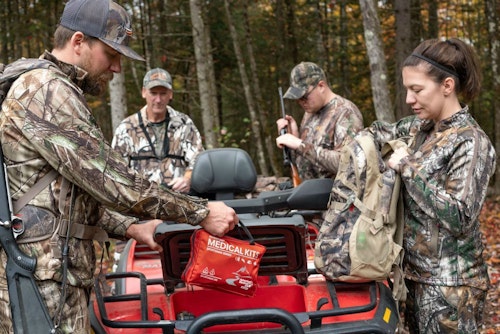Whitetails. Mule deer. Blacktails. Each autumn, it’s estimated that more than 8 million Americans hunt those three species of deer in the United States. And each year, the vast majority of those hunters eagerly spend their hard-earned money on new gear and gadgets to bring along on their deer-hunting adventures.
Deer hunters represent the largest hunting clientele for any hunting retailer, by far. A report issued by the National Shooting Sports Foundation in 2018 found that of the $27.1 billion spent annually by American hunters, an estimated $15.7 billion was spent by deer hunters. That report showed deer hunters collectively spending more than $766 million on rifles and nearly $600 million on ammunition each year.
For retailers who cater to hunters, the fact that deer hunting is the most popular pursuit should come as no surprise. Walk into any hunting shop and you’ll see guns, optics, ammo, footwear, scents and clothing well stocked and prominently displayed. Most counter associates are well-versed on the benefits of shooting a .270 and know how to correctly size a blaze orange vest for youth hunters. But there are a number of value-added accessories with healthy margins that retailers should consider adding to their offerings that deer hunters gobble up by the tens of thousands.
In the old days, hunting retailers might sell hand warmers and a selection of knives to cater to the deer-hunting crowd. As hunters have grown more demanding and sophisticated, many of the specialty products they want to bring along when they venture afield can best be purchased online. But it doesn’t have to be that way. A wide variety of products take up minimal in-store space and offer good profit margins that retailers should consider carrying for the deer hunters who walk through their doors. Here are a few examples.
Socks
For decades, hunters spent good money on their hunting boots but didn’t pay much attention to their feet beyond that. They slid their feet into big, heavy, one-size-fits-all wool socks that bunched up or, worse yet, into cheap cotton socks better suited for the gym or leisurely strolls around town. In most places, deer hunters suffered through cold feet, particularly those who endured a few frozen hours huddled in ground blinds or tree stands.
Thankfully, socks have come a long way. Hunting-specific socks made with wool and blended with technical fabrics dominate the market today. Hunting socks made for specific hunting styles are available — whether that’s stand-hunting on a cold Midwestern prairie, tracking through deep New England snow or moving fast and light through public lands in the Southeast.
Besides taking up minimal space and in addition to the usual keystone markup, socks offer retailers a chance to appeal to deer hunters throughout the year. A hunter who comes to appreciate good socks in November will likely be back for a pair during spring turkey season or for use in an early fall archery season.
Premium socks from manufacturers such as Darn Tough, Smartwool and Farm to Feet typically have a retail price between $20 and $25. But that $25 can go a long way. Darn Tough, for example, offers terrific support to its retailers with an unconditional guarantee for life, meaning if a hole or rip develops, Darn Tough will replace them for free at the point of sale. That gives customers yet another reason to return to the outdoor shop where the socks were purchased.
High-end socks, which are available in myriad sizes, also provide for great upsell potential for a hunter who just spent $200 on a pair of boots.
Headlamps
Light and lamp technology sure has changed in recent years, with LED lighting units getting brighter, smaller and less expensive. The days of having to use massive lanterns to find your way out of the woods at night or track wounded animals after sunset are long gone.
Outdoor equipment companies such as Black Diamond or Petzl, both of which have proven track records of servicing specialty retailers, offer a wide assortment of affordable lighting options made to meet the demand of hard use.
Profit margins on headlamps are usually pretty solid — about 40% through most manufacturers. One of the good things about headlamps is their lack of seasonality, meaning there’s no need to mark them down at the end of the selling season.
Repair Kits
We’re not talking big money here, but consider carrying some adhesives, sealants, tapes and patches for hunters to use on packs and clothing.
Gear Aid, for instance, is a go-to brand for outdoor repair kits. While the sale of repair kits likely won’t keep the electricity bill paid, it gives hunters another reason to come into your store.
Food Products
Ever stand in the check-out line at a Dick’s Sporting Goods? Dick’s smartly makes customers wander past a display case of candy bars, gums and beef jerky to get to the counter. Smart retailers should simply steal from the big-box playbook, especially with beef jerky.
Hunters love jerky. It’s lightweight and packable, meaning they can throw it in their hunting backpack for a long day afield or just a few hours in the stand. It’s also relatively inexpensive, but important for retailers is that a beef jerky display case takes up very little room.
Perhaps just as important: Beef jerky sales are on the way up. According to Beef magazine (a trade publication), meat as a convenient snack will drive sales in the upcoming year. The global meat snacks market was valued at $7 billion in 2019, according to the magazine, with an anticipated growth of 7 to 8% in the next five years.
Jerky brands recognize the importance of the hook-and-bullet crowd. Bridgford, for example, is a major sponsor of anglers on the FLW and Bassmaster Tour. While some of the bigger-named jerky brands may require high minimum orders and may not distribute to smaller one-off accounts, consider this: Just about every state has a homegrown jerky maker who’s more than willing to work with the local sporting goods store to get products in front of consumers. If the bigger brands won’t work with your store — although many do — try the local jerky maker up the road.
First-Aid Kits
Back in the 1970s, participants in hunter education courses often had to make a small first-aid kit as part of the curriculum. Twelve-year-old boys would delight in filling up a Band-Aid box with items like surgical tape, a few cotton balls and maybe a small tin of salve. Luckily, the first-aid kit is another value-added product that has benefited from technological advances in recent years, and outdoor enthusiasts who appreciate a prepared mindset have come to embrace the idea of simply buying pre-made kits.
First-aid kit manufacturers have taken notice of hunters, hikers and other outdoor enthusiasts. Adventure Medical Kits, for instance, has an entire “Sportsman Series” designed to treat hunters in the field who suffer cuts, breaks, sprains and other common injuries.
And, like beef jerky, there’s plenty of growth potential there. A market study on first-aid kits indicate an annual growth rate in sales of about 5% over the next five years, going from $280 million in US sales in 2019 to a projected $370 million in 2024. Additionally, in light of the COVID pandemic, more Americans have embraced the preparedness lifestyle, as evidenced by the boom in 2020 of self-defense items and firearms.
First-aid kits are typically priced on size, with MSRPs ranging from $25 to more than $100.
Deer hunters are an eclectic bunch. Some are content to hunt in a box stand wearing a pair of jeans for a couple hours after work; others will spend the fall months on the road hunting high mountain tops, camping on their own and buying licenses in multiple states. Retailers who provide a mix of products to this diverse and large group of consumers should see growth in the store’s sales.









